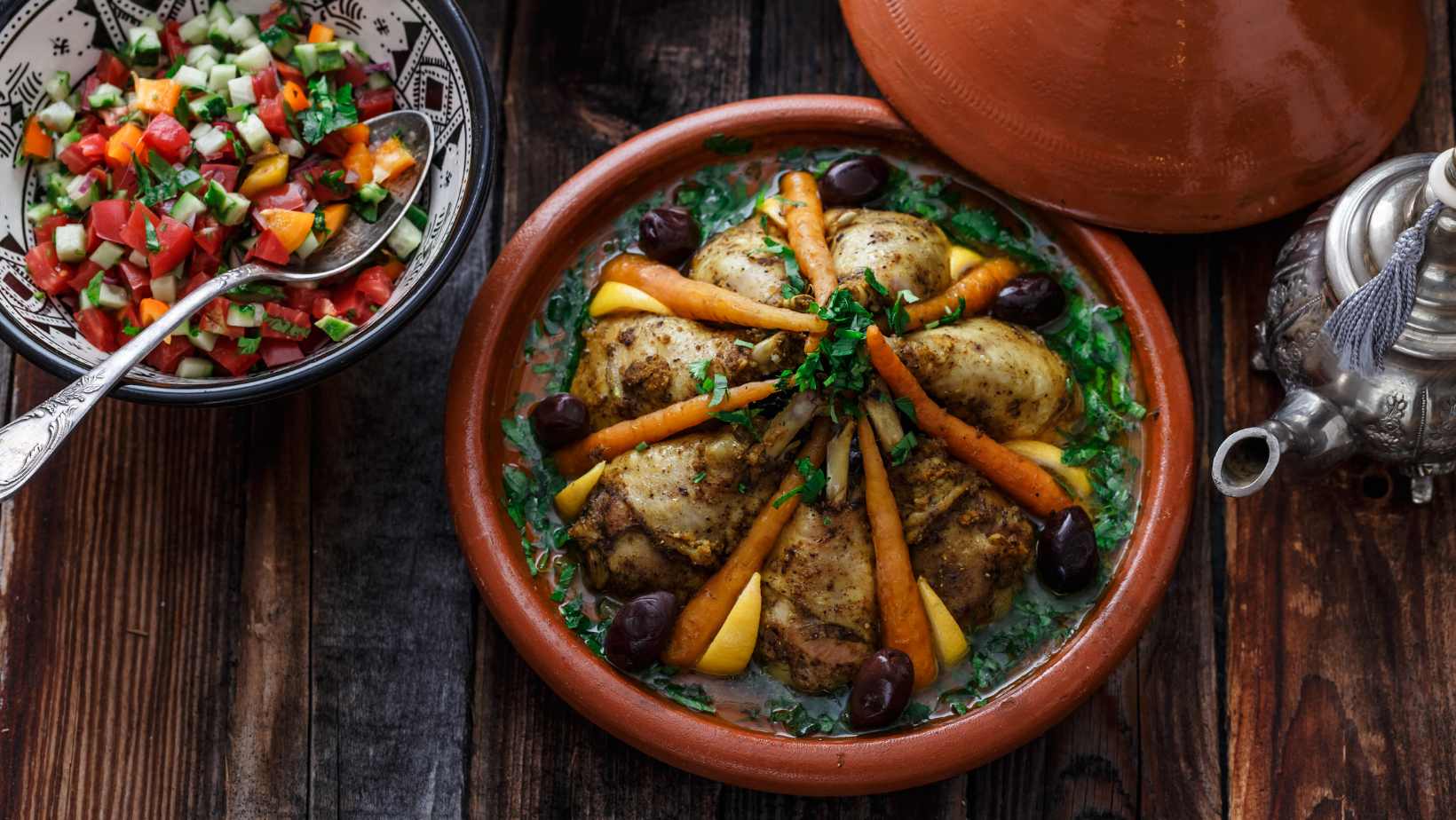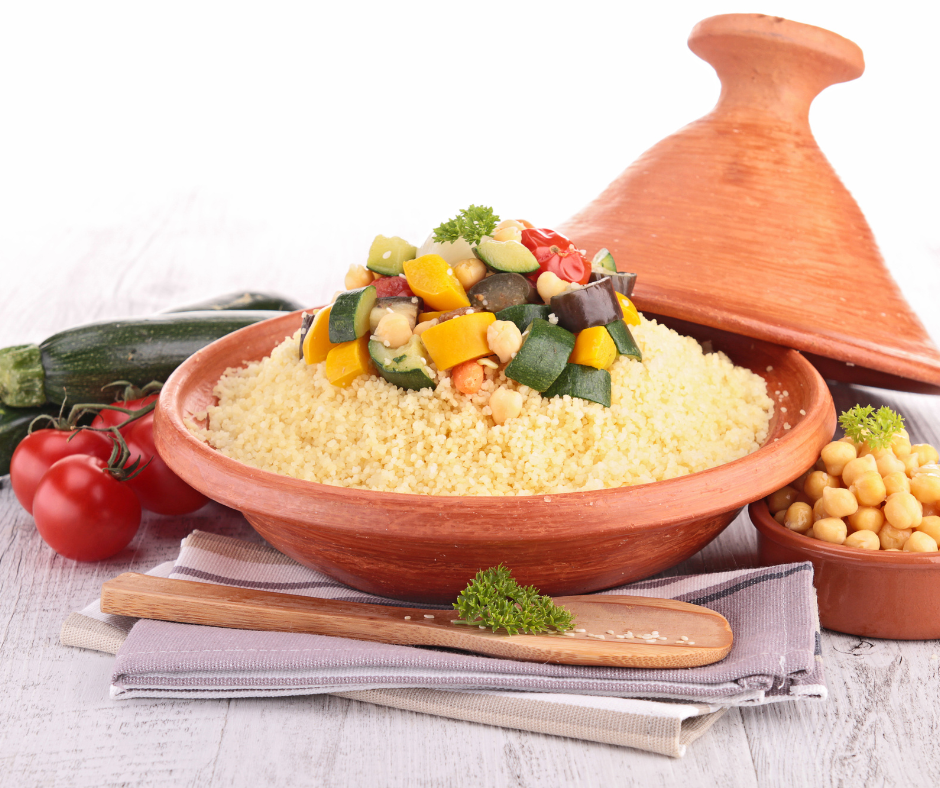
The Best of Moroccan Food: 9 Essential Dishes to Try
Moroccan food is a vibrant tapestry of flavors, spices, and cultural influences. With its rich history and diverse culinary traditions, Morocco offers a gastronomic experience like no other. In this article, we will explore ten essential types of Moroccan food that will transport you to the bustling souks and aromatic kitchens of this North African gem. From fragrant tagines to mouthwatering pastries, let’s embark on a culinary journey through the tantalizing world of Moroccan cuisine.
Tagine
Cook it at home
Tagine is a beloved Moroccan food that has gained worldwide acclaim for its delicious flavors and unique cooking method. This traditional Moroccan dish is cooked in a cone-shaped earthenware pot called a tagine, which helps infuse the ingredients with intense aromas and flavors. The tagine is typically filled with a delectable combination of tender meats, such as lamb or chicken, and a variety of aromatic spices, dried fruits, and vegetables.
The slow-cooking process allows the ingredients to meld together, resulting in a rich and flavorful stew-like dish. Tagine embodies the essence of Moroccan cuisine, showcasing the country’s vibrant culinary traditions and cultural heritage. Its popularity continues to grow as people around the globe are captivated by the tantalizing tastes and inviting aromas of this iconic Moroccan food.
Couscous
Cook it at home
Couscous is a staple in Moroccan cuisine and serves as a versatile base for various dishes. Made from semolina grains, this fluffy and delicate pasta is often accompanied by succulent meats, aromatic vegetables, and savory sauces. Couscous is a must-try dish that showcases the heart of Moroccan cooking.
Harira
Cook it at home
During Ramadan, Moroccans break their fast with a comforting bowl of Harira soup. This nourishing tomato-based soup is enriched with lentils, chickpeas, fragrant herbs, and spices. It embodies the essence of Moroccan comfort food and is often served with dates and sweet pastries.

Pastilla
Cook it at home
Pastilla, a delightful Moroccan food, is a true culinary gem that has captured the hearts of food enthusiasts worldwide. This traditional Moroccan dish is a savory pie known for its unique blend of flavors and textures. Pastilla typically features layers of delicate, flaky pastry filled with a succulent mixture of spiced meat, usually chicken or pigeon, along with almonds, eggs, and a hint of aromatic spices like cinnamon and saffron.
This combination creates a symphony of sweet and savory flavors that is both exotic and comforting. Topped with a dusting of powdered sugar and a sprinkle of ground cinnamon, Pastilla offers a tantalizing balance of tastes. It is a testament to the rich culinary heritage of Morocco, showcasing the country’s diverse influences and skilled craftsmanship. Pastilla is a must-try for anyone seeking an authentic and unforgettable Moroccan dining experience.
Moroccan Mint Tea
Moroccan mint tea, also known as Maghrebi tea, is a cherished symbol of Moroccan hospitality. This refreshing and aromatic tea blends green tea leaves with fresh mint and an abundance of sugar. Served in ornate tea glasses, this traditional drink is an integral part of Moroccan social gatherings.
Moroccan mint tea and hospitality go hand in hand, representing the warmth and generosity deeply ingrained in Moroccan culture. Mint tea, known as “atay bana” or “Moroccan whiskey,” is a beloved traditional beverage that symbolizes hospitality and welcoming gestures. It is customarily served to guests as a gesture of friendship and respect.
The preparation of Moroccan mint tea is an art form in itself, with the tea leaves brewed with fresh mint leaves and sugar, creating a sweet and refreshing flavor. The tea is poured from a height into small glasses, signifying the host’s effort to create a frothy and enticing experience for their guests. This ritual extends beyond the act of serving tea; it embodies the essence of Moroccan hospitality, where visitors are treated with warmth, open arms, and a genuine desire to make them feel at home. Moroccan mint tea not only quenches thirst but also fosters a sense of camaraderie and connection, making it an integral part of the Moroccan cultural experience.

Mechoui
Cook it at home
Mechoui is a beloved Moroccan barbecue dish that showcases the country’s love for roasted meats. Typically made with lamb or goat, the meat is marinated in a blend of spices and slow-roasted until tender and succulent. Mechoui is a true delight for meat enthusiasts.
Zaalouk
Cook it at home
Zaalouk is a flavorful Moroccan salad made with roasted eggplant, tomatoes, garlic, and a blend of spices. This smoky and aromatic dish can be enjoyed as a side or as a dip with crusty bread. Zaalouk adds a refreshing and healthy element to any Moroccan meal.
Moroccan Lentil Soup (Word Count: 171) Moroccan lentil soup is a comforting and nutritious dish that is popular throughout the country. Made with lentils, vegetables, and a blend of spices, this hearty soup is a staple during the colder months. It is often served with crusty bread for a complete meal.
Moroccan Sweets
Moroccan sweets, an integral part of Moroccan food, are a delightful assortment of treats that entice the taste buds with their unique flavors and intricate designs. One popular Moroccan sweet is “M’hanncha,” also known as the “Snake Cake.” This dessert features a delicate spiral of almond paste and fragrant spices wrapped in layers of crispy, golden phyllo pastry.
M’hanncha is often garnished with a sprinkling of powdered sugar and crushed pistachios, adding a touch of elegance to its appearance. Another beloved Moroccan sweet is “Chebakia,” a traditional pastry made from a dough infused with orange blossom water, sesame seeds, and a blend of warming spices. The dough is intricately folded into a flower-like shape before being fried until crisp and golden. Once cooked, Chebakia is immersed in a fragrant honey syrup, allowing it to absorb the sweetness and become irresistibly sticky. These Moroccan sweets not only satisfy the sweet tooth but also showcase the country’s culinary creativity and artistry.
In addition to M’hanncha and Chebakia, Moroccan cuisine boasts an array of other delectable sweets. “Ghriba” is a popular choice, featuring crumbly cookies made with almonds, sesame seeds, and a hint of rosewater or orange blossom water. The “Briouats” are another Moroccan delicacy, consisting of thin pastry triangles filled with a variety of fillings, including sweetened almonds, nuts, or a delectable blend of honey and cinnamon.
“Sellou” is a unique sweet made from roasted flour, almonds, sesame seeds, and spices, all blended together to create a nutty and aromatic treat. These Moroccan sweets reflect the country’s rich culinary heritage, with their distinct flavors and intricate preparations. Whether enjoyed during festive occasions or as a daily indulgence, Moroccan sweets provide a delightful taste of the country’s culinary traditions and are sure to leave a lasting impression.
Berber connection to Moroccan Food
The Berber people have a deep and rich connection to cuisine, which reflects their centuries-old traditions and cultural heritage. The Berber cuisine, prevalent in North Africa, particularly in countries like Morocco, Algeria, Tunisia, and Libya, showcases a remarkable blend of indigenous ingredients, culinary techniques, and historical influences.
Berber cuisine is characterized by its use of locally sourced, fresh ingredients such as aromatic herbs, spices, grains, legumes, vegetables, and meats. Staple foods like couscous, tagines, and flatbreads are prevalent in Berber cooking, often flavored with a variety of spices like cumin, coriander, turmeric, and saffron.
The cuisine also incorporates ingredients like olives, dates, almonds, honey, and preserved lemons, offering a delightful balance of flavors. Berber cuisine is not just a means of sustenance, but it is also a way for the Berber people to celebrate their cultural identity and pass down their culinary traditions from one generation to the next.
Trying Moroccan Food while travelling
Eating Moroccan food while travelling is a gastronomic adventure that immerses travelers in the vibrant flavors and cultural richness of the country. From savoring tagines bursting with aromatic spices to indulging in fluffy couscous, every meal is a delightful exploration of Moroccan cuisine. The diverse range of dishes, such as the iconic pastilla, fragrant mint tea, and delectable Moroccan sweets, provides a culinary experience that showcases the country’s culinary heritage. Whether dining in a bustling medina or a cozy riad, each bite is an opportunity to embrace the flavors of Morocco and discover the unique blend of spices, textures, and ingredients that make Moroccan food so enticing.
Moreover, sampling Moroccan food during a trip not only satisfies the taste buds but also offers a glimpse into the country’s rich cultural traditions and warm hospitality. Sharing a communal tagine or breaking bread with locals is a cherished experience that fosters connections and creates lasting memories. From street food stalls to elegant restaurants, Moroccan cuisine caters to all tastes and budgets, making it accessible and enticing for all travelers.
The vibrant colors, exotic scents, and intricate flavors of Moroccan food create a sensory journey that is as captivating as the sights and sounds of the country. For those seeking an authentic and immersive travel experience, indulging in Moroccan food is an essential part of the journey, providing a window into the heart and soul of Morocco.
Moroccan food is a vibrant and aromatic fusion of flavors that captivates the senses. From the iconic tagines to the delightful pastries, each dish showcases the rich culinary heritage of Morocco. Whether you’re exploring the bustling streets of Marrakech or savoring Moroccan cuisine in your own kitchen, these ten essential dishes are a must-try for anyone seeking a gastronomic adventure. Embark on a culinary journey and let the tantalizing flavors of Moroccan food transport you to the exotic world of North Africa.
Want to take a trip to Morocco to try all this amazing Moroccan food? Why not check out our food tour to Morocco ‘Spice Odyssey‘?


Leave a Reply